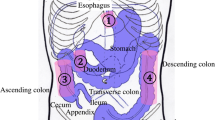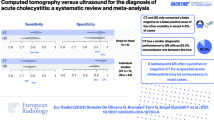Abstract
Purpose
In surgery for strangulated bowel obstruction, intestinal blood flow (IBF) is usually evaluated by observing bowel colour, peristalsis, intestinal temperature and arterial pulsations in the mesentery. We investigated whether indocyanine green (ICG) fluorescence angiography (ICG-FA) is an effective alternative to palpation.
Methods
Thirty-eight patients who underwent emergency surgery for strangulated bowel obstruction from January 2017 to April 2021 were divided into two groups: (i) the ICG + group, in which ICG was used during laparoscopic surgery (n = 16), and (ii) the ICG − group, in which palpation without ICG was used during open surgery (n = 22). Starting in July 2019, ICG and laparoscopic surgery were applied in all cases except emergency cases when the fluorescence laparoscope was not ready. Surgical outcomes and patient characteristics were compared.
Results
Patient characteristics, the operative duration and postoperative hospitalization duration did not significantly differ between the groups. Bowel resection was performed in 4 cases (25%) among ICG + patients and 11 cases (50%) among ICG − patients. The ratios of pathological findings (ischaemia:mucosal necrosis:transmural necrosis) were 0:2:2 and 1:6:4 in the two groups, respectively. Blood loss was measured with gauze and suction tubes and was 1 (0–5) mL in the ICG + group and 12.5 (0–73) mL in the ICG − group (p = 0.002). Postoperative complications occurred in 1 case (6.3%) in the ICG + group and 9 cases (40.9%) in the ICG − group (p = 0.025).
Conclusion
Although there were few intestinal resections in the ICG + group, the rate of pathological necrosis tended to be high, and no complications due to ineligibility were noted in the intestinal preservation group. During laparoscopic surgery, ICG-FA is useful as a substitute for palpation and has the potential to improve surgical outcomes.
Clinical trial registration
Research Ethics Committee of the Kawaguchi Municipal Medical Center (Saitama, Japan) approval number: 2019–40




Similar content being viewed by others
Data availability
The data and material that support the findings of this study are available from the corresponding author upon request.
Code availability
None.
References
Nerup N, Svendsen MBS, Rønn JH, Konge L, Svendsen LB, Achiam MP (2021) Quantitative fluorescence angiography aids novice and experienced surgeons in performing intestinal resection in well-perfused tissue. Surg Endosc. https://doi.org/10.1007/s00464-021-08518-7
Karliczek A, Harlaar NJ, Zeebregts CJ, Wiggers T, Baas PC, van Dam GM (2009) Surgeons lack predictive accuracy for anastomotic leakage in gastrointestinal surgery. Int J Colorectal Dis 24:569–576. https://doi.org/10.1007/s00384-009-0658-6
Miyoshi N, Ohue M, Noura S, Yano M, Sasaki Y, Kishi K, Yamada T, Miyashiro I, Ohigashi H, Iishi H, Ishikawa O, Imaoka S (2009) Surgical usefulness of indocyanine green as an alternative to India ink for endoscopic marking. Surg Endosc 23:347–351. https://doi.org/10.1007/s00464-008-9938-4
Nagata J, Fukunaga Y, Akiyoshi T, Konishi T, Fujimoto Y, Nagayama S, Yamamoto N, Ueno M (2016) Colonic marking with near-infrared, light-emitting, diode-activated indocyanine green for laparoscopic colorectal surgery. Dis Colon Rectum 59:e14–e18. https://doi.org/10.1097/dcr.0000000000000542
Ozawa Y, Murakami M, Watanabe M, Yoshizawa S, Goto S, Otsuka K, Aoki T (2016) Preoperative colonic cancer tattooing using the near-infrared fluorescence laparoscopic imaging system. Asian J Endosc Surg 9:340–343. https://doi.org/10.1111/ases.12306
Ris F, Hompes R, Cunningham C, Lindsey I, Guy R, Jones O, George B, Cahill RA, Mortensen NJ (2014) Near-infrared (NIR) perfusion angiography in minimally invasive colorectal surgery. Surg Endosc 28:2221–2226. https://doi.org/10.1007/s00464-014-3432-y
Jafari MD, Lee KH, Halabi WJ, Mills SD, Carmichael JC, Stamos MJ, Pigazzi A (2013) The use of indocyanine green fluorescence to assess anastomotic perfusion during robotic assisted laparoscopic rectal surgery. Surg Endosc 27:3003–3008. https://doi.org/10.1007/s00464-013-2832-8
Sherwinter DA (2012) Transanal near-infrared imaging of colorectal anastomotic perfusion. Surg Laparosc Endosc Percutan Tech 22:433–436. https://doi.org/10.1097/SLE.0b013e3182601eb8
Jafari MD, Wexner SD, Martz JE, McLemore EC, Margolin DA, Sherwinter DA, Lee SW, Senagore AJ, Phelan MJ, Stamos MJ (2015) Perfusion assessment in laparoscopic left-sided/anterior resection (PILLAR II): a multi-institutional study. J Am Coll Surg 220:82-92.e81. https://doi.org/10.1016/j.jamcollsurg.2014.09.015
Kudszus S, Roesel C, Schachtrupp A, Höer JJ (2010) Intraoperative laser fluorescence angiography in colorectal surgery: a noninvasive analysis to reduce the rate of anastomotic leakage. Langenbecks Arch Surg 395:1025–1030. https://doi.org/10.1007/s00423-010-0699-x
Wada T, Kawada K, Takahashi R, Yoshitomi M, Hida K, Hasegawa S, Sakai Y (2017) ICG fluorescence imaging for quantitative evaluation of colonic perfusion in laparoscopic colorectal surgery. Surg Endosc 31:4184–4193. https://doi.org/10.1007/s00464-017-5475-3
Ryu S, Suwa K, Kitagawa T, Aizawa M, Ushigome T, Okamoto T, Eto K, Yanaga K (2020) Evaluation of anastomosis with ICG fluorescence method using VISERA ELITE2 during laparoscopic colorectal cancer surgery. Anticancer Res 40:373–377. https://doi.org/10.21873/anticanres.13962
Son GM, Kwon MS, Kim Y, Kim J, Kim SH, Lee JW (2019) Quantitative analysis of colon perfusion pattern using indocyanine green (ICG) angiography in laparoscopic colorectal surgery. Surg Endosc 33:1640–1649. https://doi.org/10.1007/s00464-018-6439-y
Boni L, David G, Dionigi G, Rausei S, Cassinotti E, Fingerhut A (2016) Indocyanine green-enhanced fluorescence to assess bowel perfusion during laparoscopic colorectal resection. Surg Endosc 30:2736–2742. https://doi.org/10.1007/s00464-015-4540-z
Wada T, Kawada K, Hoshino N, Inamoto S, Yoshitomi M, Hida K, Sakai Y (2019) The effects of intraoperative ICG fluorescence angiography in laparoscopic low anterior resection: a propensity score-matched study. Int J Clin Oncol 24:394–402. https://doi.org/10.1007/s10147-018-1365-5
Watanabe J, Ishibe A, Suwa Y, Suwa H, Ota M, Kunisaki C, Endo I (2020) Indocyanine green fluorescence imaging to reduce the risk of anastomotic leakage in laparoscopic low anterior resection for rectal cancer: a propensity score-matched cohort study. Surg Endosc 34:202–208. https://doi.org/10.1007/s00464-019-06751-9
Nakashima K, Ryu S, Okamoto A, Hara K, Ishida K, Ito R, Nakabayashi Y (2021) Usefulness of blood flow evaluation with indocyanine green fluorescence imaging during laparoscopic surgery for strangulated bowel obstruction: a cohort study. Asian J Surg. Online ahead of print. https://doi.org/10.1016/j.asjsur.2021.08.020
Lütken CD, Achiam MP, Osterkamp J, Svendsen MB, Nerup N (2021) Quantification of fluorescence angiography: toward a reliable intraoperative assessment of tissue perfusion—a narrative review. Langenbecks Arch Surg 406:251–259. https://doi.org/10.1007/s00423-020-01966-0
Sheridan WG, Lowndes RH, Williams GT, Young HL (1992) Determination of a critical level of tissue oxygenation in acute intestinal ischaemia. Gut 33:762–766. https://doi.org/10.1136/gut.33.6.762
Bulkley GB, Zuidema GD, Hamilton SR, OʼMara CS, Klacsmann PG, Horn SD, (1981) Intraoperative determination of small intestinal viability following ischemic injury: a prospective, controlled trial of two adjuvant methods (Doppler and fluorescein) compared with standard clinical judgment. Ann Surg 193:628–637. https://doi.org/10.1097/00000658-198105000-00014
Kawase H, Uemura S, Senmaru N, Yuasa N (2015) Diagnostic accuracy and treatment outcome of strangurated intestinal obstruction. J.A.E.M 35:543–548. (In Japanese )
Matsuzaki H, Ishihara S, Kawai K, Murono K, Otani K, Yasuda K, Nishikawa T, Tanaka T, Kiyomatsu T, Hata K, Nozawa H, Watanabe T (2018) Smoking and tumor obstruction are risk factors for anastomotic leakage after laparoscopic anterior resection during rectal cancer treatment. J Anus Rectum Colon 1:7–14. https://doi.org/10.23922/jarc.2016-012
Tai JD, Liu YS, Wang GY (2007) Risk factors and the management of anastomotic leakage after anus-preserving operation for rectal cancer. Zhonghua Wei Chang Wai Ke Za Zhi 10:153–156
Kato Y, Tamaki G, Tokumitsu M, Yamaguchi S, Yachiku S, Okuyama M (2003) A case of urolithiasis associated with short bowel syndrome. Jpn J Urol 94:33–36. https://doi.org/10.5980/jpnjurol1989.94.33
Kono K, Sekikawa T, Iizuka H, Takahashi A, Amemiya H, Takehana T, Ooi A, Fujii H, Matsumoto Y (2001) Interposed colon between remnants of the small intestine exhibits small bowel features in a patient with short bowel syndrome. Dig Surg 18:237–241. https://doi.org/10.1159/000050143
Kono K, Sekikawa T, Iizuka H, Ichihara F, Amemiya H, Ishikawa T, Matsumoto Y (1999) T-cell dysfunction in a patient with short bowel syndrome: report of a case. Surg Today 29:1253–1256. https://doi.org/10.1007/bf02482217
Schaafsma BE, Mieog JS, Hutteman M, van der Vorst JR, Kuppen PJ, Löwik CW, Frangioni JV, van de Velde CJ, Vahrmeijer AL (2011) The clinical use of indocyanine green as a near-infrared fluorescent contrast agent for image-guided oncologic surgery. J Surg Oncol 104:323–332. https://doi.org/10.1002/jso.21943
Ryu S, Yoshida M, Ohdaira H, Tsutsui N, Suzuki N, Ito E, Nakajima K, Yanagisawa S, Kitajima M, Suzuki Y (2016) Intestinal blood flow assessment by indocyanine green fluorescence imaging in a patient with the incarcerated umbilical hernia: report of a case. Ann Med Surg (Lond) 8:40–42. https://doi.org/10.1016/j.amsu.2016.04.020
Ryu S, Yoshida M, Ohdaira H, Tsutsui N, Suzuki N, Ito E, Nakajima K, Yanagisawa S, Kitajima M, Suzuki Y (2016) A case of incarcerated femoral hernia with intestinal blood flow assessment by brightfield full-color near-infrared fluorescence camera: report of a case. Int J Surg Case Rep 29:234–236. https://doi.org/10.1016/j.ijscr.2016.11.041
Ryu S, Yoshida M, Ohdaira H, Tsutsui N, Suzuki N, Ito E, Nakajima K, Yanagisawa S, Kitajima M, Suzuki Y (2017) Blood flow evaluation using PINPOINT® in a case of incarcerated inguinal hernia: a case report. Asian J Endosc Surg 10:75–78. https://doi.org/10.1111/ases.12333
Daskalopoulou D, Kankam J, Plambeck J, Ambe PC, Zarras K (2018) Intraoperative real-time fluorescence angiography with indocyanine green for evaluation of intestinal viability during surgery for an incarcerated obturator hernia: a case report. Patient Saf Surg 12:24. https://doi.org/10.1186/s13037-018-0173-1
Nitori N, Deguchi T, Kubota K et al (2014) Successful treatment of non-occlusive mesenteric ischemia (NOMI) using the hypereye medical systemTM for intraoperative visualization of the mesenteric and bowel circulation: report of a case. Surg Today 44:359–362. https://doi.org/10.1007/s00595-013-0503-y
Colavita PD, Wormer BA, Belyansky I, Lincourt A, Getz SB, Heniford BT, Augenstein VA (2016) Intraoperative indocyanine green fluorescence angiography to predict wound complications in complex ventral hernia repair. Hernia 20:139–149. https://doi.org/10.1007/s10029-015-1411-4
Guerra F, Coletta D, Greco PA, Eugeni E, Patriti A (2021) The use of indocyanine green fluorescence to define bowel microcirculation during laparoscopic surgery for acute small bowel obstruction. Colorectal Dis 23:2189–2194. https://doi.org/10.1111/codi.15680
Iinuma Y, Hirayama Y, Yokoyama N, Otani T, Nitta K, Hashidate H, Yoshida M, Iida H, Masui D, Manabe S (2013) Intraoperative near-infrared indocyanine green fluorescence angiography (NIR-ICG AG) can predict delayed small bowel stricture after ischemic intestinal injury: report of a case. J Pediatr Surg 48:1123–1128. https://doi.org/10.1016/j.jpedsurg.2013.03.067
Fukuda N, Iwahashi M, Maruoka S, Yamamoto M, Terasawa H, Kobayashi Y, Tsubota Y (2018) Two cases of delayed ischemic small bowel stenosis after surgery for an incarcerated femoral hernia. J Jpn Surg Assoc 79:1707–1714. https://doi.org/10.3919/jjsa.79.1707
Dindo D, Demartines N, Clavien PA (2004) Classification of surgical complications: a new proposal with evaluation in a cohort of 6336 patients and results of a survey. Ann Surg 240:205–213. https://doi.org/10.1097/01.sla.0000133083.54934.ae
Hayami S, Matsuda K, Iwamoto H et al (2019) Visualization and quantification of anastomotic perfusion in colorectal surgery using near-infrared fluorescence. Tech Coloproctol 23:973–980. https://doi.org/10.1007/s10151-019-02089-5
Acknowledgements
The authors would like to thank Professor Masashi Yoshida (Department of Surgery, International University of Health and Welfare Hospital) for his invaluable advice regarding fluorescence navigation surgery.
The authors would like to thank the medical staff of the Kawaguchi Municipal Medical Center.
Funding
This work was supported by the 35th Saitama Surgeons Association Research Grant.
Author information
Authors and Affiliations
Contributions
SR: data curation, formal analysis, project administration, writing—original draft, writing—review and editing, conceptualization, methodology and visualization. KH: investigation. KG: investigation. AO: investigation. TK: investigation. RM: investigation. RI: investigation. YN: supervision.
Corresponding author
Ethics declarations
Ethics approval
This study was carried out with the approval of the Kawaguchi Municipal Medical Center Ethics Committee (approval number: 2019–40).
Consent to participate
The patients consented to participate in this study for publication.
Consent for publication
The authors consent to the publication of this article.
Conflict of interest
The authors declare no competing interests.
Additional information
Publisher’s note
Springer Nature remains neutral with regard to jurisdictional claims in published maps and institutional affiliations.
Rights and permissions
About this article
Cite this article
Ryu, S., Hara, K., Goto, K. et al. Fluorescence angiography vs. direct palpation for bowel viability evaluation with strangulated bowel obstruction. Langenbecks Arch Surg 407, 797–803 (2022). https://doi.org/10.1007/s00423-021-02358-8
Received:
Accepted:
Published:
Issue Date:
DOI: https://doi.org/10.1007/s00423-021-02358-8




